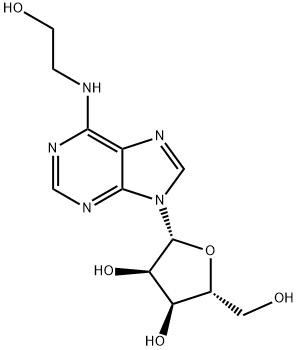|
|
| | N-(2-Hydroxyethyl)adenosine Basic information |
| Product Name: | N-(2-Hydroxyethyl)adenosine | | Synonyms: | NSC 54251;(2R,3R,4S,5R)-2-(6-((2-Hydroxyethyl)amino)-9H-purin-9-yl)-5-(hydroxymethyl)tetrahydrofuran-3,4-di;N-(2-Hydroxyethyl)adenosine;6-Hydroxyethyladenosine;N6-(2-Hydroxyethyl)adenosine;(2R,3R,4S,5R)-2-(6-((2-Hydroxyethyl)aMino)-9H-purin-9-yl)-5-(hydroxyMethyl)tetrahydrofuran-3,4-diol;(2R,3R,4S,5R)-2-(6-((2-Hydroxyethyl)amino)-9H-purin-9-yl)-5-(hydroxymethyl)tetrahydrofuran-3,4;Adenosine, N-(2-hydroxyethyl)- | | CAS: | 4338-48-1 | | MF: | C12H17N5O5 | | MW: | 311.29 | | EINECS: | 200-001-2 | | Product Categories: | | | Mol File: | 4338-48-1.mol |  |
| | N-(2-Hydroxyethyl)adenosine Chemical Properties |
| Melting point | 194-195℃ | | Boiling point | 725.8±70.0 °C(Predicted) | | density | 1.88 | | storage temp. | Keep in dark place,Sealed in dry,Room Temperature | | solubility | DMSO (Slightly), Methanol (Slightly) | | form | Solid | | pka | 13.11±0.70(Predicted) | | color | White to Off-White |
| | N-(2-Hydroxyethyl)adenosine Usage And Synthesis |
| Uses | N-(2-Hydroxyethyl)adenosine has been studied as an anticonvulsant through the activation of adenosine A1 receptor (AA1R). | | in vivo | N6-(2-Hydroxyethyl)adenosine (20-40 mg/kg, ip, once daily for 6 weeks) reduces the blood glucose level and diabetes-induced kidney damage, increases the activities of antioxidant enzymes (such as SOD, catalase CAT and GSH) in renal tissue, reduces the level of malondialdehyde (MDA), exhibits anti-inflammatory and antioxidant activities, and ameliorates Alloxan (HY-W017227)-induced diabetes in rats models[2].
N6-(2-Hydroxyethyl)adenosine (75-150 mg/kg, po, once daily for 19 days) exhibits antitumor effect in SGC-7901 xenograft mouse models[4].
| Animal Model: | Alloxan-induced diabetes in rats models[2] | | Dosage: | 20-40 mg/kg | | Administration: | ip, once daily for 6 weeks | | Result: | Reduced the levels of blood glucose, serum creatinine (Scr), blood urea nitrogen (BUN) and urine protein.
Reduced the levels of TNF-α, IL-1β, IL-6, TGF-β1 and NF-κB in kidney tissue.
Alleviated the damage of glomeruli and renal tubules.
|
| Animal Model: | SGC-7901 xenograft mouse models[4] | | Dosage: | 75-150 mg/kg | | Administration: | po, once daily for 19 days | | Result: | Reduced tumor volume and weight. |
|
| | N-(2-Hydroxyethyl)adenosine Preparation Products And Raw materials |
|